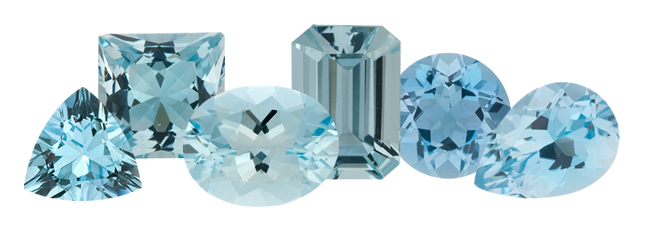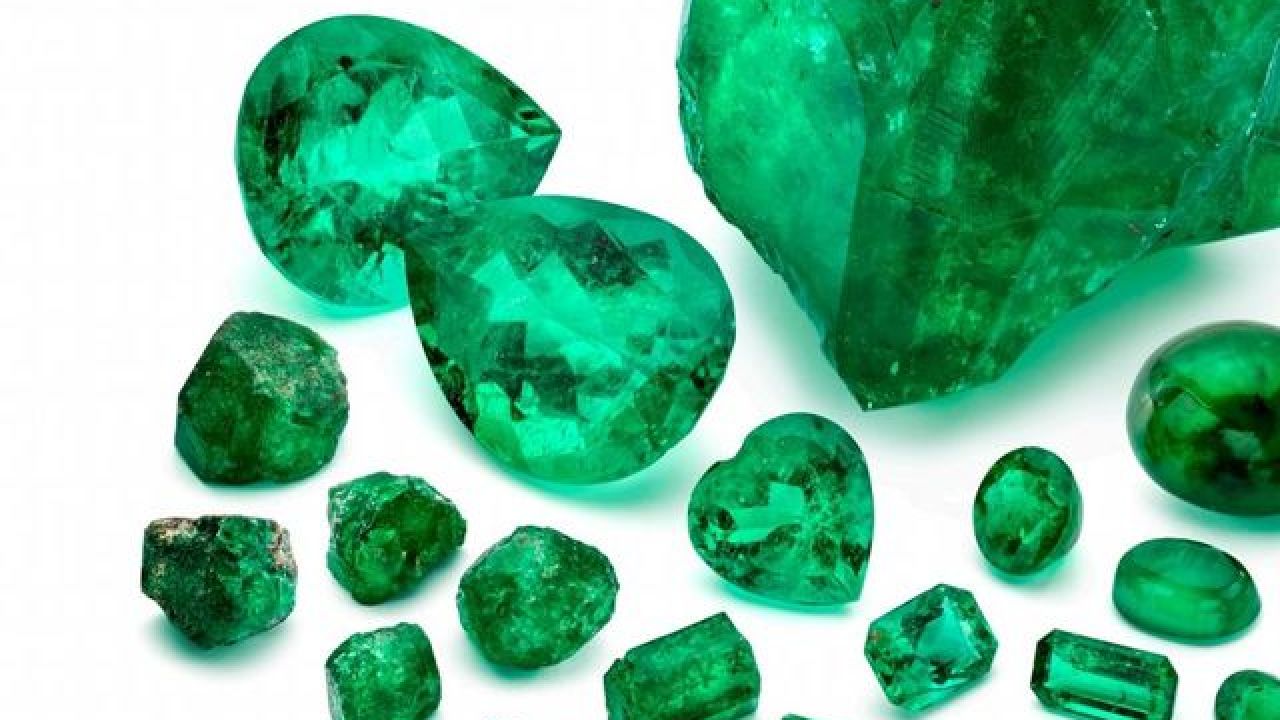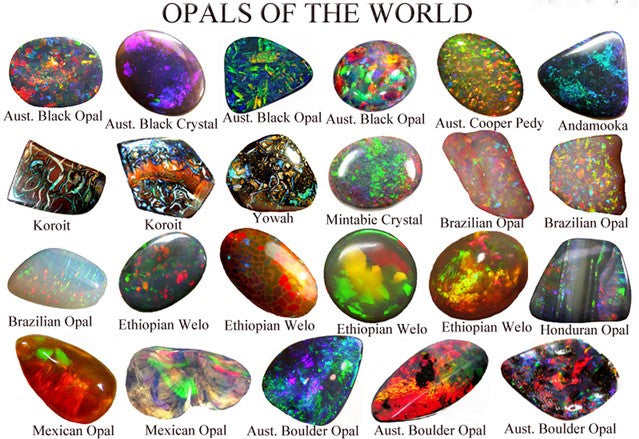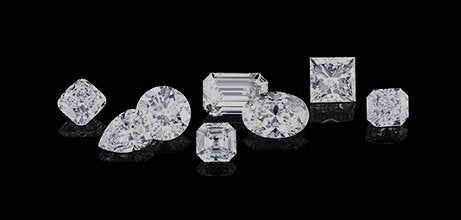Gemstone Education
THE STORY OF ALEXANDRITES

One of the most versatile and captivating stones, natural Alexandrite is one of the few precious gems that changes color from a bluish green in white light to a purple in incandescent lighting.
Mined today in India, Brazil, and Sri Lanka, Alexandrites range in color from bluish-green to pink, purple or purplish-red, these gems are most commonly fashioned into mixed cuts, showcasing kite-shaped and triangular facets or concentric rows of parallel facets.
Extremely rare and sought-after, this gem was named after the Russian Tsar Alexander II and can often be more expensive than gems like Diamonds, Rubies, Emeralds or Sapphires.
Considered a mystical or magical stone, natural Alexandrite is said to be associated with good omens, while boosting the wearer’s intuition and also aiding creativity and inspire imagination.
THE STORY OF AQUAMARINES

The very name aquamarine brings to mind the clear blue tint of the sea. Legend says that Neptune, the King of the Sea, gave aquamarine as gifts to the mermaids, and from then on, it has brought love to all who have owned it. Aquamarine was long thought to have a soothing influence on married couples, making it a good anniversary gift.
Aquamarines are found in a range of blue shades, from the palest pastel to greenish-blue to a deep blue. While the choice of color is largely a matter of taste, the deeper blue gemstones are more rare. Remember that Aquamarine is a pastel gemstone, and while color can be quite intense in larger gemstones, the smaller aquamarines are often less vivid.
This elegant gemstone is the birthstone of March and is the symbol of youth, hope, health and fidelity. Aquamarines are mined in a number of exotic places including Nigeria, Madagascar, Zambia, Pakistan and Mozambique, but most of the gemstones available today come from Brazil.
Many aquamarines are greenish when mined and cut. For those who prefer a purer blue, these gemstones are heated to enhance their blue color permanently. Some aquamarine fanciers prefer the greenish hues, saying the greener tones remind them more of the sea. The color tones of aquamarine are subtle and varied. Their soft luster is a wonderful addition to any natural colored gemstone jewelry collection.
DIAMONDS
The most famous gemstone in the world.
Said to be “a girl’s best friend”, the name derives from the ancient Greek word ‘adamas’ meaning invincible. In the gem world, more people are employed in mining and cutting Diamonds, than for any other gemstone. The quality of this gem’s color, clarity and cut are more tightly measured than for any other gemstone, and although there are various standards used across the globe, that of the Gemological Institution of America (GIA) is the most widely used.
Diamond is a gemstone made of pure, native crystallized carbon. The value of a similar carat weight of Diamonds can vary dramatically, based on their clarity and color - and to some extents more importantly - how well the gemstone has been cut.
As the hardest natural mineral known to man, measuring 10 on the Mohs scale, Diamonds can only be cut and faceted by other Diamonds, and although they are extremely hard, they are also quite brittle, making them one of the more difficult gems for lapidarists to shape.. One of the main differences to other gemstones is that a lack of color is highly prized. The closer to colorless a Diamond becomes, the better dispersion (the splitting of light into its constituent colors) it will display.
For those interested in studying advertising and marketing, the rise of the Diamond to the status of “the world’s most popular gemstone” (overtaking many rarer, more colourful gems, gems who have been linked with royalty, religion and powerful leaders for thousands of years, gems who are steeped in folk lore and legend), is a real textbook marketing campaign.
Although Africa is still a major supplier of Diamonds, today it holds less than 50% of the market share, and it cannot control the market as much as it once did. New big players on the scene include India, Canada, Russia, Australia and Brazil.
It’s taken for granted that the larger the carat weight of a good quality gem, the larger the price, but why is this the case? In simplistic terms, larger gems are rarer than smaller gems and in the case of Diamonds, only one in a million faceted Diamonds are said to weigh over one carat.
THE STORY OF EMERALDS

Regarded as the stone of nature, the dazzling greens of Emeralds are known to represent youth, hope, renewal, and growth; as well as the talisman for harmony, compassion, and justice.
The ancient Egyptians mined emeralds nearly 4,000 years ago, and Cleopatra was an avid collector. South America's rich bounty of emeralds was discovered by 16th Century Spanish explorers who found large emeralds in the possession of the Aztecs and Incas. Believed by the ancients to empower the owner with foresight into the future, emerald is regarded as an amulet for good fortune.
Emerald, to many, symbolizes rebirth and the abundance of the life force. The rich green hue brings to mind the regeneration of life in spring and hope of new possibilities. Emerald is the birthstone for May and a talisman for Gemini.
Spring can also be seen in the network of inclusions in the depth of the emerald that the French call the jardin, or garden, because it resembles foliage. The inclusions are like a fingerprint, giving each emerald a distinct personality and distinguishing them as truly natural gemstones. Emeralds are a Type III gemstone, which means that natural inclusions are expected to be present.
Today, most of the world's emeralds are mined in Colombia, Brazil and Zambia. Emeralds can be cut in a variety of different shapes, ranging from the traditional rectangular step-cut, known as the "emerald cut," to rounds, ovals, squares and cabochons.
THE STORY OF OPAL

Opals are beautiful gems, with the finest Family Opal specimens containing every color of the rainbow. The name means ‘precious stone’, and is thought to have come from the Latin “Opalus” and the Greek “Opallios”.
Their unique internal colors are one of the most fascinating visual effects created by nature, and their optical properties they display is correctly referred to as “play of color”. Opals are doubly attractive as they often also have a beautiful iridescence (known as ‘opalescence’).
Opals were created from hydrated silicon dioxide, and were formed when water-based solutions containing silica, deposited a gel- like substance in gaps and crevices in rocks. Because of this they often form around areas where there are hot springs or geysers. Gem-quality Opals do, however, have a crystal structure. They are loved for their kaleidoscope of colors and internal flashes of almost neon colored lights. There are several varieties of gem-quality Opals and the names used for them by the gemstone industry can be quite confusing to many people. When you hear White Opal, Grey Opal or Black Opal, the name is referring to the background color of the Opal. See it as a canvas for a painting on which beautiful colors are to be thrown in a random inspiration of modern art.
Boulder Opal consists of fine layers of natural Opal which have formed naturally on ironstone rock. Much like Ammolite, it is removed from its host rock while it is being cut, and then placed back onto it. This means that for most Boulder Opal the finished gem is actually a doublet or triplet opal. Boulder Opal from Queensland is declared by many experts to have the most brightness and best appearance of the Australian Opals.
Common Opals can be found all over the world, whereas gem-quality Opals are mostly mined in Australia; in fact, some reports claim that 97% of the world’s gem-quality Opals are sourced from here. Other areas are Mexico, South Africa, Brazil, Honduras, United States, Czech Republic, Guatemala and Romania.
THE STORY OF PARAIBA TOURMALINE

THE STORY OF RUBY

The gem of love, Ruby is the red member of the Corundum family and is often given as a gift to show the strength of one’s relationship. Its rich, vivid red colors are due to the presence of chromium and its almost identical twin sister, the Sapphire, is similar in all but color.
Celebrated in the Bible and in ancient Sanskrit writings as the most precious of all gemstones, rubies have been the prized possession of emperors and kings throughout the ages. Ruby's inner fire has been the inspiration for innumerable legends and myths, and to this day, no red gemstone can compare to its fiery, rich hues. It was believed wearing a fine red ruby bestowed good fortune on its owner.
For many centuries, Ruby has been thought to remove sadness, prevent nightmares, and protect against many illnesses including inflammatory diseases.
Many people associate its brilliant crimson colors with passion and love, making ruby an ideal choice for an engagement ring. Ruby is the red variety of the corundum mineral species, while all other colors of corundum are called sapphire.
This most sought after gemstone is available in a range of red hues, from purplish and bluish red to orangish red. Ruby is readily available in sizes up to 2 carats, but larger sizes can be obtained. However, in its finest quality, any size ruby can be scare. In readily available small sizes, ruby makes an excellent accent gemstone because of its intense, pure red color.
Ruby is mined throughout Southeast Asia. Some of the finest Rubies are from Burma, where their color is said to be comparable to that of "pigeon blood". Other sources include Thailand, Vietnam, Sri Lanka, Kenya, Madagascar, Tanzania, Cambodia, and India.
After being extracted from the earth, rubies today are commonly heated to high temperatures to maximize the purity and intensity of their red hue. Impurities may also dissolve or become less noticeable after heating. However, heating will only improve the color if the gemstone already contains the chemistry required. Occasionally rubies with small imperfections are permeated with a silicate byproduct of the heating process, which helps to make small fissures less visible. This enhancement, like heating, is permanent and rubies, whether enhanced or not, remain among the most durable of gems.
It is said that over 95% of the Rubies on the market today have been heat-treated, therefore, whenever buying a Ruby it is best to assume that the gem has been heated. Unheated and untreated Rubies command a premium in the marketplace, and are extremely rare over 1 carat. When buying an unheated Ruby, you should insist on a valid gemological report. Large natural Rubies of good color and clarity are so valuable that they often demand a higher price per carat than even the most flawless diamonds.
Ruby is the birthstone for July, and is also the Anniversary gemstone for both the 15th and 40th year of marriage. With a hardness of 9 on the Moh's scale, it is a tough and durable gemstone. When set in a precious metal, your Ruby should continue to sparkle and shine for thousands of years to come.
THE STORY OF SAPPHIRES

Long ago, it was decided that all gemstones of the mineral "Corundum" should be referred to as sapphire, except the red color, which was called ruby. Other very popular shades of fancy sapphires are; yellows, bright oranges, lavenders and purples, and these are usually offered at more modest prices.
The wide array of differing hues seen in Sapphires is due to the presence of different natural impurities found in their crystal structure. Blue Sapphires are formed due to the presence of Titanium. Chromium trapped inside Corundum allows us to enjoy Pink Sapphire, and in larger quantities and saturation, gives us the Ruby.
The most valuable fancy sapphire is an orange-pink or pinkish-orange variety called 'Padparadscha' after the lotus blossom. Padparadscha sapphires are very rare, and the exact definition should always be authenticated by a gemological laboratory report. Padparadscha sapphires are the rarest sapphires on the planet and sell at a premium; their prices exceeding those obtained for fine blue sapphires. Their beauty, with its delicate blended shades the color of fresh salmon and sunsets, is obvious.
Generally, the clearer and more vivid the color, the more valuable the sapphire. If the color is in the pastel range, the clarity should be good. Because in lighter tones inclusions are more noticeable, the trade usually prefers the gemstones to be cleaner with fewer visible inclusions. In a lighter colored gemstone, the cut is also more important: it should reflect light back evenly across the face of the stone, making it lively and brilliant. With darker, more intense colors, the cut is not as critical because the color creates its own impact.
When admiring a Sapphire, turning it back and forth will allow the light to travel through the gemstone and display even more colors; this beautiful array of colors emitted as the gem is moved is known as pleochroism.
Sapphires are found in countries as far afield as Madagascar, Australia, Thailand, and China. The most highly regarded Sapphires come from a country known as "gem island", which is Sri Lanka. These Sapphires, especially when blue, are known as Ceylon Sapphires, and command incredibly high prices per carat, particularly when they are not heat-treated. Unheated and untreated Sapphires make up less than 5% of the Sapphire kingdom, and therefore command higher prices. When considering an unheated Sapphire of any color, get a valid gemological report to authenticate it's non-treated status.
Sapphire is the birthstone of September. It is also the gift for the 5th, 45th, and 70th Anniversaries. It's hard crystal structure measures a 9 on the Moh's scale, making it incredibly durable. When set in precious metal, it should continue to sparkle for many years to come.
No matter what the color, sapphires combine durability and beauty for generations of pleasure.
THE STORY OF SPINEL

Spinel has long been one of the most under-appreciated gemstones on the market, yet it is coveted by collectors and gemologists for its range of hues and spectacular optical properties. Spinel was recently added as an official birthstone for August, raising its exposure to new heights.
Recognized and prized for its hardness, brilliance, and unlike many other gem types, spinel is rarely treated or enhanced in any way. Many believe the name spinel comes from the Greek word for ’spark’. This name suits spinel well since it is a singularly refractive stone and is formed with cubic crystals similar to diamond, which gives this gemstone remarkable brilliance and fire.
Spinels are an attractive alternative to ruby and sapphire as the same trace elements that color corundum are also what colors different colors of spinels, which come in an array of colors- ranging from a continuum of intense reds and pinks, down to the cool hues of blue and violet. Chromium causes the fiery red color of red spinels, and a mixture of cobalt and iron colors the striking blue color of stones from Sri Lanka. Sri Lanka is a top source for blue “cobalt” spinels, which are sought after for their vivid, intense blue color. In addition, the Mogok region of Myanmar (much like Burmese rubies) is a renowned source for the finest red and hot-pink spinel. While all colors of spinel are beautiful in their own way, red is the rarest in nature and the most valuable. In addition to similar trace elements, and sources that are shared with ruby and sapphire, spinels form in the same metamorphic rock as corundum and are found in the same deposits.
THE STORY OF TOURMALINE

Tourmaline has been fascinating collectors for thousands of years, although it was not identified as a gem variety in its own right until 1703, when a parcel of mixed gems was sent from Ceylon to Holland. The package was simply labelled “turmali”, which translates from Sinhalese to “mixed precious stones”.
This exquisite gemstone naturally occurs in a myriad of all the stunning colors of the rainbow, and its crystal structure makes it look like it is almost pre-faceted by Mother Nature. With other gemstone families, the presence of different natural elements during the time the gem was crystallizing has provided Tourmaline with an array of spectacular colors. A deep vivid green, rich in chromium, is named "Chrome Tourmaline". Iron-rich Tourmalines are normally black to deep brown and magnesium-rich varieties can occur in a yellowish brown color. Red Tourmalines are called "Rubellite". Copper bearing tourmalines in the green and blue ranges are called "Paraiba Tourmalines" . Lithium-rich Tourmalines come in a rainbow of other colors.
Tourmaline is pleochroic, which means you can see different colors when viewed from different angles. As well as being pleochroic, the crystals may grow to be green at one end and pink at the other: this variety is called "Bi- Colored" Tourmaline. When found with green on the outside and pink inside, they are known as "Watermelon Tourmaline".
When Tourmalines are heated or rubbed they create an electrical charge, and for this reason non gem-quality specimens are used in electrical devices. This unique ability to attract particles is known as "Pyroelectricity".
The folklore and legend surrounding Tourmaline has only begun to emerge in the last few hundred years. Tourmaline is considered a good luck gem and is sometimes referred to as the “stone of wisdom”. It is also said to be “resistant to all vagaries of fate” – in other words, it protects the person wearing it from ill fortune. It is the gemstone of friendship, relationships and love, and is said to help strengthen and intensify these. Believed to possess healing warmth, if you hold the gemstone it has been said it can balance your “prana,” the energy of your soul. It is also said that Tourmalines encourage artistic intuition. In fact, Tourmaline is known to have many faces and expresses every mood.
Tourmalines are found in various parts of the world; however, most on the market today are from Brazil and Africa. That said, there is also a Tourmaline mine in Maine, California that has been in operation since 1822.
THE STORY OF TSAVORITE GARNET

Tsavorite Garnet is said to comfort and warm the heart, and also stimulates the immune system. It has also been said that Tsavorite can be used as a gentle pain reliever and can sometimes treat problems with eyesight.
Vividly brilliant green and beautiful: The green colors found in Tsavorite garnet are lovely and highly desirable. Tsavorite Garnet was discovered by British gem prospector Campbell R. Bridges in the mountains of north-east Tanzania in 1967. The name Tsavorite was chosen by Tiffany & Co in reference to the initial discoveries in the area in and around Tsavo National Park.
A member of the garnet group, the species name is grossularite and the variety name is Tsavorite. Tsavorite Garnet is considered to be the most valued variety of the grossularite species because stones over three carats in size are especially rare. For this reason, Tsavorite Garnet gemstones of two carats or more are particularly coveted and extremely valuable.
Tsavorite is the name usually associated with the darker green garnets, as a lighter green garnet is called a "mint garnet". A great characteristic of tsavorite is its durability, with a hardness similar to Emerald, 7.5 on the Mohs' Scale, it is a far more durable gemstone.
Sources of this gemstone are becoming rapidly depleted in Kenya, with reports stating that during the last few years, yields are down by 80%.

